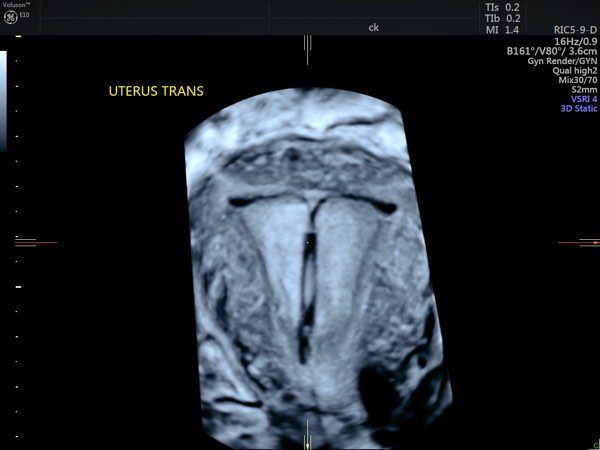Heavy or painful periods
Gynaecological ultrasound to evaluate painful periods.
Painful periods: how a scan can help
Painful periods are a common reason to request a gynaecology ultrasound. Your doctor might be worried about fibroids, endometriosis, or other conditions visible to ultrasound. Heavy periods can also be caused by these conditions, as well as by changes in the lining of the uterus, such as polyp growths or abnormal thickening. Some women have more than one purpose for the request: apart from heavy or painful periods, they might also be experiencing bleeding between periods, pelvic pain or other symptoms.


When to plan an ultrasound for painful periods
If you have been requested to get an ultrasound in regards to painful or heavy periods, and you are menstruating regularly, the best time of the cycle for the ultrasound is usually from day 5 to day 11 (counting from the first day of your period).
If endometriosis is the specific concern, later in the cycle is sometimes more helpful. During the period is a good time to avoid as this is likely to be a more uncomfortable time to be scanned. When preparing for your ultrasound, please make note of the first day of your last menstrual period as closely as you can, so you can let us know.
If there is bleeding between your periods, the timing can be difficult to work out. If you are bleeding all or most of the time, do not delay your ultrasound appointment. If you are using the oral contraceptive pill, the stage of the cycle is not important for your scan. It is recommended to bring the packet or provide the name of the pill you use.
Painful periods ultrasound: what to expect?
A gynaecological ultrasound may consist of 2 different scans: an abdominal ultrasound and a vaginal ultrasound.
If you expect to be having a vaginal ultrasound, two glasses of any liquid is enough to drink, ideally 3/4 of an hour before. A brief abdominal scan will be done first, but then the bladder can be emptied. With a vaginal ultrasound, a narrow probe is inserted after bladder emptying. Most of the scan information comes from the vaginal pictures, so it’s not necessary for the bladder to be over-full beforehand.
Related Information
- Read more about what to expect with a Gynaecological Ultrasound.
- Have questions for either pregnancy or gynaecology scans? See our FAQs.
- Have an appointment with us and want to know what to expect? See our patient practical information section.
- Do you need an ultrasound? Make a booking.
- Learn more about the team and QDOS Ultrasound.
- Please feel free to provide us with your feedback.

Uterus Scan with Mirena Contraceptive inserted.
If you only want to have an abdominal ultrasound, bladder filling is even more important because it adds clarity to the scan. Usually 3 large glasses of fluid 3/4 of an hour before your appointment is realistic.
Also allow for extra time at your visit: if the bladder is not full enough, we may require you to wait and fill your bladder more. It can take a long time, and for this reason young girls and adolescents are not booked late in the day.
If using hormone therapy or vaginal estrogen, do not cease purely for the ultrasound. If anything, they make the ultrasound easier for you.
About Qdos Ultrasound Perth
QDOS Ultrasound Perth is a specialised O&G ultrasound practice. We assess by live scanning information, which gives more information than still pictures. Dr Kristy Milward has worked in O&G for over a decade and has a special interest in Gynaecological Ultrasound. She is also involved in teaching and training specialist registrars and GPs.
QDOS Ultrasound was established as “Park Ultrasound” in 1994 by Dr Bev Hewitt, who also performs gynaecological scans at QDOS and who combines a specialist O&G background, with extensive ultrasound qualifications and experience. QDOS is located in West Leederville, Perth.
Bleeding after Menopause
Lack of Periods
Lack of periods is one of the common symptoms triggering a request from your referring doctor, for a gynaecological ultrasound.
Bleeding between periods
Send Us an Email
Contact QDOS Ultrasound
12 Connolly St, West Leederville
PERTH - Western Australia 6007
| Phone | 08 9481 4008 |
| Fax | 08 9481 4080 |
Monday - Friday
8:00 am - 4:45 pm
(strictly by appointment only)
Parking/Transport
Click here for more information.
